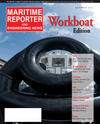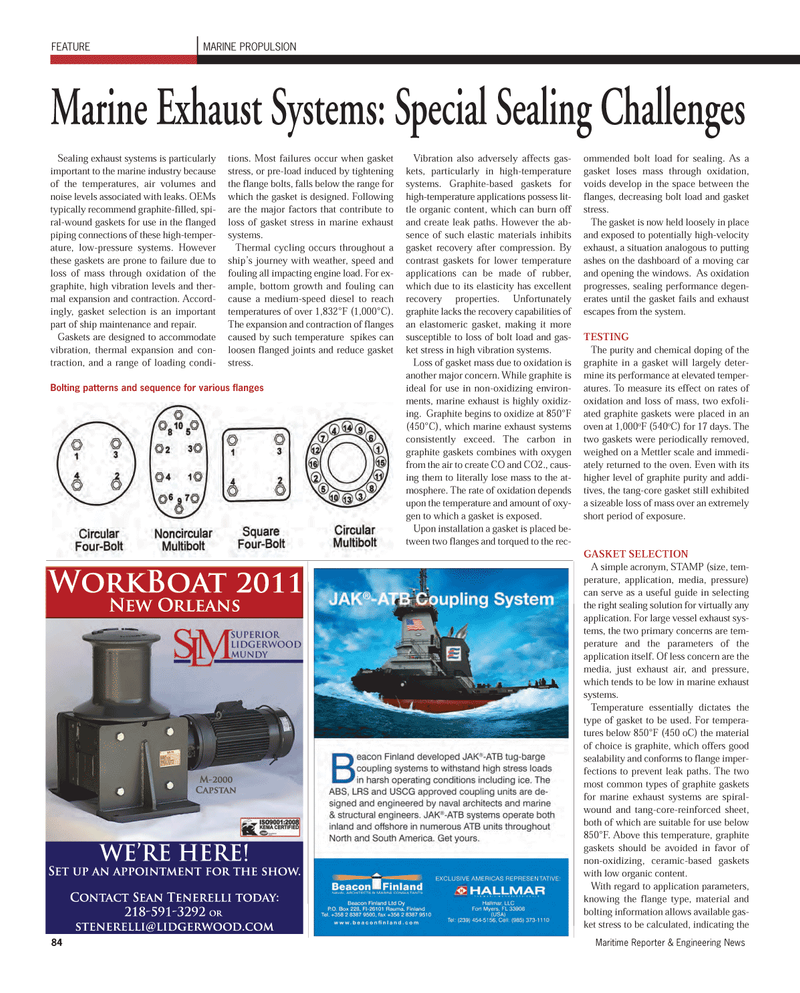
Page 84: of Maritime Reporter Magazine (November 2011)
Feature: Workboat Annual
Read this page in Pdf, Flash or Html5 edition of November 2011 Maritime Reporter Magazine
Sealing exhaust systems is particularly important to the marine industry becauseof the temperatures, air volumes and noise levels associated with leaks. OEMs typically recommend graphite-filled, spi- ral-wound gaskets for use in the flanged piping connections of these high-temper- ature, low-pressure systems. However these gaskets are prone to failure due to loss of mass through oxidation of thegraphite, high vibration levels and ther- mal expansion and contraction. Accord- ingly, gasket selection is an important part of ship maintenance and repair. Gaskets are designed to accommodate vibration, thermal expansion and con- traction, and a range of loading condi-tions. Most failures occur when gasket stress, or pre-load induced by tighteningthe flange bolts, falls below the range for which the gasket is designed. Following are the major factors that contribute to loss of gasket stress in marine exhaust systems.Thermal cycling occurs throughout a ship?s journey with weather, speed and fouling all impacting engine load. For ex- ample, bottom growth and fouling can cause a medium-speed diesel to reachtemperatures of over 1,832°F (1,000°C). The expansion and contraction of flanges caused by such temperature spikes can loosen flanged joints and reduce gasket stress. Vibration also adversely affects gas- kets, particularly in high-temperature systems. Graphite-based gaskets for high-temperature applications possess lit-tle organic content, which can burn off and create leak paths. However the ab- sence of such elastic materials inhibitsgasket recovery after compression. By contrast gaskets for lower temperature applications can be made of rubber, which due to its elasticity has excellent recovery properties. Unfortunately graphite lacks the recovery capabilities of an elastomeric gasket, making it more susceptible to loss of bolt load and gas- ket stress in high vibration systems. Loss of gasket mass due to oxidation is another major concern. While graphite is ideal for use in non-oxidizing environ- ments, marine exhaust is highly oxidiz- ing. Graphite begins to oxidize at 850°F (450°C), which marine exhaust systems consistently exceed. The carbon in graphite gaskets combines with oxygen from the air to create CO and CO2., caus-ing them to literally lose mass to the at-mosphere. The rate of oxidation depends upon the temperature and amount of oxy-gen to which a gasket is exposed. Upon installation a gasket is placed be- tween two flanges and torqued to the rec- ommended bolt load for sealing. As a gasket loses mass through oxidation, voids develop in the space between the flanges, decreasing bolt load and gasket stress. The gasket is now held loosely in place and exposed to potentially high-velocity exhaust, a situation analogous to putting ashes on the dashboard of a moving car and opening the windows. As oxidation progresses, sealing performance degen- erates until the gasket fails and exhaust escapes from the system. TESTINGThe purity and chemical doping of thegraphite in a gasket will largely deter- mine its performance at elevated temper- atures. To measure its effect on rates of oxidation and loss of mass, two exfoli- ated graphite gaskets were placed in an oven at 1,000 oF (540oC) for 17 days. The two gaskets were periodically removed, weighed on a Mettler scale and immedi-ately returned to the oven. Even with its higher level of graphite purity and addi- tives, the tang-core gasket still exhibited a sizeable loss of mass over an extremely short period of exposure. GASKET SELECTION A simple acronym, STAMP (size, tem- perature, application, media, pressure)can serve as a useful guide in selectingthe right sealing solution for virtually any application. For large vessel exhaust sys- tems, the two primary concerns are tem- perature and the parameters of theapplication itself. Of less concern are themedia, just exhaust air, and pressure, which tends to be low in marine exhaust systems. Temperature essentially dictates the type of gasket to be used. For tempera- tures below 850°F (450 oC) the material of choice is graphite, which offers good sealability and conforms to flange imper- fections to prevent leak paths. The two most common types of graphite gaskets for marine exhaust systems are spiral- wound and tang-core-reinforced sheet, both of which are suitable for use below 850°F. Above this temperature, graphite gaskets should be avoided in favor of non-oxidizing, ceramic-based gaskets with low organic content. With regard to application parameters, knowing the flange type, material and bolting information allows available gas- ket stress to be calculated, indicating the 84Maritime Reporter & Engineering News FEATURE MARINE PROPULSION Marine Exhaust Systems: Special Sealing Challenges Bolting patterns and sequence for various flangesMR Nov.11 # 11 (82-88):MR Template 11/4/2011 11:28 AM Page 84

 83
83

 85
85
